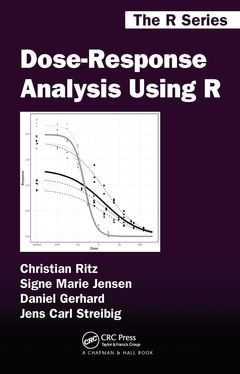Dose-Response Analysis Using R Chapman & Hall/CRC The R Series
Auteurs : Ritz Christian, Jensen Signe Marie, Gerhard Daniel, Streibig Jens Carl

Nowadays the term dose-response is used in many different contexts and many different scientific disciplines including agriculture, biochemistry, chemistry, environmental sciences, genetics, pharmacology, plant sciences, toxicology, and zoology.
In the 1940 and 1950s, dose-response analysis was intimately linked to evaluation of toxicity in terms of binary responses, such as immobility and mortality, with a limited number of doses of a toxic compound being compared to a control group (dose 0). Later, dose-response analysis has been extended to other types of data and to more complex experimental designs. Moreover, estimation of model parameters has undergone a dramatic change, from struggling with cumbersome manual operations and transformations with pen and paper to rapid calculations on any laptop. Advances in statistical software have fueled this development.
Key Features:
- Provides a practical and comprehensive overview of dose-response analysis.
- Includes numerous real data examples to illustrate the methodology.
- R code is integrated into the text to give guidance on applying the methods.
- Written with minimal mathematics to be suitable for practitioners.
- Includes code and datasets on the book?s GitHub: https://github.com/DoseResponse.
This book focuses on estimation and interpretation of entirely parametric nonlinear dose-response models using the powerful statistical environment R. Specifically, this book introduces dose-response analysis of continuous, binomial, count, multinomial, and event-time dose-response data. The statistical models used are partly special cases, partly extensions of nonlinear regression models, generalized linear and nonlinear regression models, and nonlinear mixed-effects models (for hierarchical dose-response data). Both simple and complex dose-response experiments will be analyzed.
Introduction
Dose-response models
Estimation procedures
Model selection and model averaging
Model diagnostics and how to fix violations
Inverse regression
Simultaneous inference
Grouped data
Nonlinear mixed effects models
Design of experiments
Appendix
Christian Ritz is an Associate Professor at the University of Copenhagen, Denmark.
Signe M. Jensen is an Assistant Professor at the University of Copenhagen, Denmark.
Daniel Gerhard is a Senior Lecturer at the University of Caterbury, New Zealand.
Jens Carl Streibig is Professor Emeritus at the University of Copenhagen, Denmark.
Date de parution : 06-2021
15.6x23.4 cm
Disponible chez l'éditeur (délai d'approvisionnement : 14 jours).
Prix indicatif 56,31 €
Ajouter au panierDate de parution : 07-2019
15.6x23.4 cm
Thèmes de Dose-Response Analysis Using R :
Mots-clés :
Log Logistic Model; Fitted Dose Response Model; AIC Weight; Full Maximum Likelihood Method; Wald Type Confidence Intervals; Cumulative Distribution Function; Dose Response Model; Marginal Confidence Intervals; Error T-value; Error DF T-value; Germination Curve; Fitted Dose Response Curve; Function Nlme; BMDL; LC50 Value; Residual Standard Error; Proportional Odds Assumption; BMD Estimate; Technical Grades Material; BMD; Multinomial Data; Negative Binomial Model; Error Lower Upper; Log Normal Model; Dose Response Data



